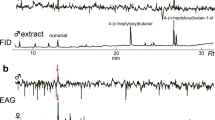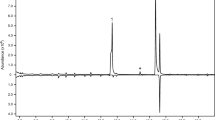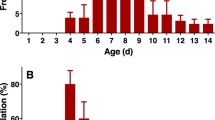Abstract
Megaplatypus mutatus (=Platypus mutatus) (Coleoptera: Platypodidae) is an ambrosia beetle that is native to South America. It attacks only standing live trees and causes severe stem breakage and death in commercial poplar (Populus) plantations. Previous work showed that male M. mutatus emits a sex pheromone composed mainly of (+)-sulcatol and sulcatone. We collected male volatile emissions during the hours of maximum emergence by using a specific polar microextraction phase; analyzed the extract by GC-MS; and tested the biological activity of selected compounds in the extract with a walking behavioral assay. Female M. mutatus emerged primarily between 7 and 11 h. In the chemical analyses of volatiles, a third compound, 3-pentanol, was identified in a small percentage of samples. Walking behavioral bioassays with video image analysis showed that at the doses tested, 3-pentanol elicited an attractive response from females.







Similar content being viewed by others
References
Achinelli, F. G., Liljersthröm, G., Aparicio, A., Delgado, M., Jouanny, M., and Mastrandrea, C. 2005. Daños por taladrillo (Megaplatypus mutatus (= Platypus sulcatus)) en plantaciones de álamo (Populus spp.) de Alberti, Buenos Aires: análisis preliminar de la magnitud y distribución de fustes quebrados. Rev. Asoc. Ftal. Arg. 59:8–11. (In Spanish).
Alfaro, R., Humble, L. M., Gonzalez Audino, P., Villaverde, R., and Allegro, G. 2007. The threat of the ambrosia beetle Megaplatypus mutatus (Chapuis) [=Platypus mutatus Chapuis] to world poplar resources. Forestry 80:471–479.
Alzogaray, R. A., Fontán, A., and Zerba, E. 2000. Repellency of deet to nymphs of Triatoma infestans. Med. Vet. Entomol. 14:6–10.
Fontán, A., González Audino, P., Martínez, A., Alzogaray, R. A., Zerba, E. N., Camps, F., and Cork, A. 2002. Attractant volatiles released by female and male Triatoma infestans (Hemiptera: Reduviidae), a vector of Chagas disease: chemical analysis and behavioral bioassays. J. Med. Entomol. 39:191–197.
Gatti Liguori, P., Zerba, E., and Gonzalez Audino, P. 2007. New trap for emergent Megaplatypus mutatus. Can. Entomol. 139:894–896.
Gonzalez Audino, P., Villaverde, R., Alfaro, R., and Zerba, E. 2005. Identification of volatile emissions from Platypus mutatus (=sulcatus) (Coleoptera: Platypodidae) and their behavioral activity. J. Econ. Entomol. 98:1506–1509.
Manrique, G., Vitta, A., Ferreira, R., Zani, C., Rikard, Unelius, C., Lazzari, C., Diotaiuti, L., and Lorenzo, M. 2006. Chemical communication in Chagas disease vectors. Source, identity, and potential function of volatiles released by the metasternal and Brindley’s glands of Triatoma infestans adults. J. Chem. Ecol. 32:2035–2052.
Milligan, R. H., and Ytsma, G. 1988. Pheromone dissemination by male Platypus apicalis White and P. gracilis Broun (Col., Platypodidae). J. Appl. Ent. 106:113–118.
Perez, A. L., Campos-Piedra, Y., Chinchilla, C. M., Oehlschlager, A. C., Gries, G., Gries, R., Castrillo, G., Giblin-Davis, R. M., Peña, J. E., Duncan, R. E., Gonzalez, L. M., Pierce, Jr, H. D., Mcdonald, R., and Andrade, R. 1995. Aggregation pheromones and host kairomones of the West Indian sugarcane weevil, Metamasius hemipterus sericeus (Oliv.) (Coleoptera: Curculionidae). J. Chem. Ecol. 23:869–888.
Santoro, H. F 1963. Bioecología de Platypus sulcatus Chapuis (Coleoptera: Platypodidae). Revista de Investigaciones Forestales 4:47–79. (In Spanish).
Statistica’99, 1999. StatSoft, Inc., Kernel Release 5.5 A ©1984–1999. Tulsa, OK (USA).
Vaurie, P. 1966. A revision of the Neotropical genus Metamasius (Coleoptera: Curculionidae, Rhynchophorinae). Species groups I and II. Bull. Am. Mus. Nat. Hist. 131:213–337.
Witzgall, P., and Arn, H. 1990. Direct measurement of the flight behavior of male moths to calling females and synthetic pheromones. Zeitschrift für Naturforschung 45c:1067–1069.
Wood, S. L. 1993. Revision of the genera of Platypodidae (Coleoptera). Great Basin Nat. 53:259–281.
Wood, S. L. 2007. Bark and Ambrosia Beetles of South America (Coleoptera, Scolytidae). Brigham Young University, M.L. Bean Life Science Museum, Provo, Utah, 900 pp.
Acknowledgments
This work was supported by the Agencia Nacional de Promoción Científica y Técnica (PICT 2005) and the University of San Martín. PGL received a doctoral grant from the University of San Martin. PGA, EZ, and RA are members of the Researcher Career of the CONICET of Argentina.
Author information
Authors and Affiliations
Corresponding authors
Rights and permissions
About this article
Cite this article
Gatti Liguori, P., Zerba, E., Alzogaray, R.A. et al. 3-Pentanol: A New Attractant Present in Volatile Emissions from the Ambrosia Beetle, Megaplatypus mutatus . J Chem Ecol 34, 1446–1451 (2008). https://doi.org/10.1007/s10886-008-9547-7
Received:
Revised:
Accepted:
Published:
Issue Date:
DOI: https://doi.org/10.1007/s10886-008-9547-7




